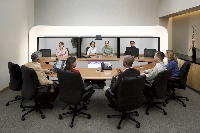Video communication with a laptop computer
By Catalogs Editorial Staff

Telepresence hailed as most impressive new technology for virtual communications
Telepresence is changing the face of communication, videoconferencing and even laptop video communication. If you haven’t yet heard of Telepresence, you might be interested to know that it has been ranked by Business Week as one of the impressive technologies in the realm of virtual communications.
Telepresence is a spin off of two conferencing technology companies that were founded in the early 1990’s; TelePort and TeleSuite. A major study regarding the advancement of these technologies in connection with key sociological and engineering issues was undertaken by the University of Toronto in a three year, five-million dollar pre-competitive research project called The Ontario Telepresence Project.
Today, the Telepresence name is owned by Cisco and celebrated as a higher level of video conferencing, featuring improved technical sophistication, and improved audio and video fidelity.
Initially, Telepresence was used primarily by major corporations for meetings, conferences, and collaborations. Today, Telepresence has be implemented by a vast range of large and small companies, educational and medical institutions, bringing meetings to the laptops and desks of busy executives, students, professors and medical professionals.
In University settings, Telepresence has enabled professors to offer remote office hours, during which students can interact via laptop video communication. Telepresence has also been widely implemented by distance learning programs, and utilized by professors and students who maybe traveling or studying abroad.
~
Hospitals and medical centers have used Telepresence to foster communications between experts, staff and doctors in various global locations, and to help students view live surgeries and procedures remotely.
Telepresence has become an essential, efficient and productive method for conducting face-to-face meetings across geographic distances.
Economists agree that a weakening economy, coupled with rising fuel and airfare costs, may be contributing to the success of Telepresence. Across the globe, corporations are cutting back on travel expenses and business trip budgets. Rather than traveling to participate in face-to-face meetings, it is becoming increasingly common place to conduct meetings via Telepresence, for a huge savings on cost, time and travel.
Telepresence is far superior to any phone conferencing systems because it offers the visual aspect, portrayed on high resolution plasma monitors, or even through laptop video communication. The visual element enhances communications because it allows meeting participants to register facial expressions, gestures, and other body language of fellow participants. Every individual participating in the meeting can dial in to the session and directly view, and talk with other members on a screen or on multiple screens. Ultimately, this simulates the feeling of being in the same room with all the meeting participants.
Telepresence systems can be installed on desktop and laptop computers. However, corporations and other institutions using Telepresence for larger scale meetings will need to equip board rooms or conference roots with VoIP phones, and plasma monitors or flat screen monitors that can stream the natural size images of the meeting participants.
Some additional recommendations and basic elements required to implement a Telepresence location in a larger scale corporate, educational or medical institution are listed below:
1. Room size has to be 15 x 20 squared meters
2. Few or no windows at all to reduce glare
3. Lighting adjustments (if needed)
4. Dedicated power to room
5. Internet connectivity
Resources:
Wikipedia: Videoconferencing
What is video conferencing?
Popular Savings Offers











